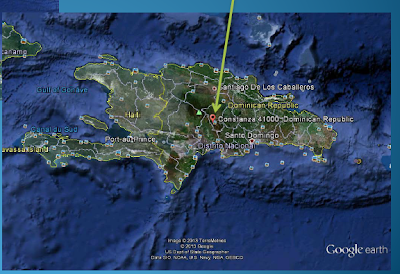Dr. Thomas Evans recently presented a case study on integrated pest and disease management at the 69th Annual Meeting of the Potomac Division of the American Phytopathological Society held in Shepherdstown, West Virginia. The findings presented by Dr. Evans were based on his team's
Farmer to Farmer trips to the Dominican Republic's Constanza valley. Dr. Evans is a professor of plant pathology at the University of Delaware and his teammate Dr. Keil is a professor of Enthomology at the Catholic University of Ecuador, South America. They have worked together on eight volunteer assignments in the Dominican Republic since 2008. A final F2F assignment is planned for May 2013 where part of their agenda includes a Tomato Spotted Wilt Tospovirus (TSWV)/ Thrips Summit meeting with key packers and growers in the Constanza Valley. The findings presented in West Virginia will serve as a framework for the planned Summit meeting.
 |
| Google Earth Map identifying the location of the Constanza Valley |
The Constanza Valley is located in the center of the island of Hispaniola at the height of 4,000 feet (1220 meters) in the middle of the Cordillera Central (Central Range). Open field production dates to the 1950s-1980s, the start of the large-scale greenhouse vegetable industry began in 2002 through grants and support from the Spanish government. Dr. Evans and Dr. Keil have focused their work on integrated pest and disease management as a way to address the re-emergence of the Tomato Spotted Wilt Tospovirus (TSWV) and Western Flower Thrips (WFT) observed in the Constanza Valley since 2009. Substrate from burned rice hulls have been used in the greenhouse productions in Constanza, resulting in excessive fertigation and have been found to be directly correlated with higher thrips populations. TSWV has a wide host range in both greenhouse and open field productions, making it an enormous challenge to develop and implement effective disease management programs.
 |
| Western Flower Thrips threaten a variety of crops including peppers |
As part of the disease management plan, Dr. Evans and Dr. Keil have promoted the mapping of the Constanza Valley with Google Earth tools and smart phones to determine the locations of all the susceptible crops and vegetable greenhouses. Part of the plan was also the selection of 5 fields and greenhouses that had thrips populations in varied crops for scouting during March, April and May. In addition to mapping and scouting, the plan includes conducting immunostrip testings of select plants to measure the incidence of TSWV and promote biological controls. For the Constanza Valley Summit, the team will present the valley-wide issues, possible solutions and hope to foster a discussion for a unified management plan for thrips and TSWV in open fields and greenhouse vegetable productions.
 |
| FTF volunteers make use of GIS mapping tools as a way to monitor and contain thrips populations |




.png)

Comments
Post a Comment